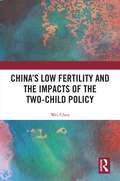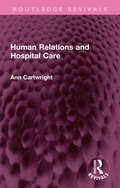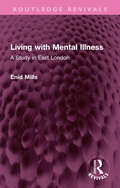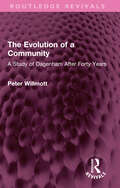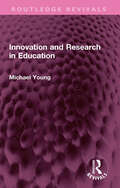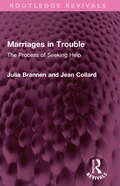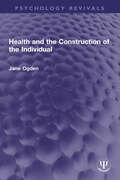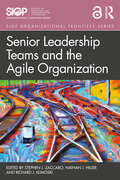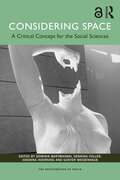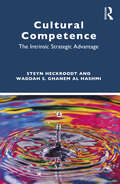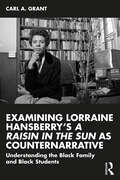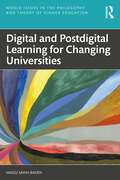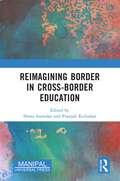- Table View
- List View
China's Low Fertility and the Impacts of the Two-Child Policy
by Wei ChenThis book examines China’s fertility transition over the past seven decades and explores the socioeconomic impacts of the two-child policy. The first half of the book highlights the characteristics of China’s low fertility and the risk of falling to an ultra-low state, aiming to answer the question: How China’s fertility is changing and evolving? How common is China’s fertility? What are the demographic structure, driving forces and institutional characteristics of China’s low fertility? The second half models the impacts of the two-child policy on China’s population trends and demands for women, infant and child health services, education resources for preschool, compulsive education, and medical and health expenditure, addressing the questions of how the two-child policy affects fertility behaviours of Chinese women, particularly the second-child fertility? How would the two-child policy impact China’s future population trends, particularly labour supply and population ageing? What are the consequences for obstetrics and gynaecological services, paediatrics and childcare services; and for school capacity and demand for teachers over compulsory education? The book will be an essential read to students and scholars of Chinese studies, population and demography studies, and those interested in contemporary China.
China's Low Fertility and the Impacts of the Two-Child Policy
by Wei ChenThis book examines China’s fertility transition over the past seven decades and explores the socioeconomic impacts of the two-child policy. The first half of the book highlights the characteristics of China’s low fertility and the risk of falling to an ultra-low state, aiming to answer the question: How China’s fertility is changing and evolving? How common is China’s fertility? What are the demographic structure, driving forces and institutional characteristics of China’s low fertility? The second half models the impacts of the two-child policy on China’s population trends and demands for women, infant and child health services, education resources for preschool, compulsive education, and medical and health expenditure, addressing the questions of how the two-child policy affects fertility behaviours of Chinese women, particularly the second-child fertility? How would the two-child policy impact China’s future population trends, particularly labour supply and population ageing? What are the consequences for obstetrics and gynaecological services, paediatrics and childcare services; and for school capacity and demand for teachers over compulsory education? The book will be an essential read to students and scholars of Chinese studies, population and demography studies, and those interested in contemporary China.
Human Relations and Hospital Care (Routledge Revivals)
by Ann CartwrightOriginally published in 1964, this book describes the hospital service as it is seen by patients. It is based mainly on interviews with a random sample of patients and discusses the relationships between patients and between them and hospital doctors, nurses, and general practitioners. The best available medical care should not only be given, but the patient and his relatives should feel that this has been given. Explanations need to be seen not as a lavish appendage, but as an integral part of medical care. Recognition and acceptance of this responsibility could stimulate interest in patients' social lives, so that hospital staff become more aware of the difficulties patients may encounter when they leave hospital. This in turn could lead to greater integration between the hospital and welfare services and between the hospital and the general practitioners. Still relevant today this study can now be read in its historical context.
Living with Mental Illness: A Study in East London (Routledge Revivals)
by Enid MillsThe Mental Health Act of 1959 marked a turning point in national policy on mental illness. Originally published in 1962, this book reports a sociological survey of a group of people from an East London borough who entered a large mental hospital in 1956 and 1957, at the very time when a Royal Commission was preparing the report upon which the new legislation was based. Living with Mental Illness shows what happened to these mental patients and to their relatives, and tells of their reactions and impressions. The impact of mental illness on their domestic and social circumstances is described, as is the part played in their lives by the social services; and the relationship between people’s perceptions of mental illness and their attitudes to hospital is discussed. Enid Mills considers the prospects for ‘community care’ of the mentally ill in the borough studied, and concludes, as Professor Morris Carstairs says in his Foreword, with ‘a review of the difficulties which must be overcome if the transition is to be effected from an outmoded, remote mental hospital system to a community-based service which will be at once efficient and humane’.
The Evolution of a Community: A Study of Dagenham After Forty Years (Routledge Revivals)
by Peter WillmottIn earlier studies, Peter Willmott and other investigators had documented the social problems of new housing estates – the loneliness, the tensions, the disruption of family and neighbourhood ties. But how far are such troubles transitory? What kind of life would develop in communities like these when time had rubbed off the newness? Originally published in 1963, in search of an answer, Peter Willmott went to Dagenham in Essex, where forty years before the London County Council began to build a giant estate to rehouse people from the East End of London. His study – of a new estate that had now become an old one – throws light on the long-term effects of this kind of migration. He found at Dagenham, most strikingly, that a way of life very similar to a ‘traditional’ working-class community had grown up. In this book he discusses the similarities and differences, and shows the influences which had worked for and against this development. After a sketch of the estate’s history, he traces the relationships of the people of Dagenham with relatives, friends and neighbours, and then examines their attitudes to each other, to politics and to social class. His conclusions were not only relevant to housing and town planning policy, but provided insight into the meaning of social class in contemporary Britain at the time.
Innovation and Research in Education (Routledge Revivals)
by Michael YoungOriginally published in 1965, this title looks at programmed learning, language laboratories, curricular reform, educational television, team teaching – these are just some of the fashions that were going to change education in the following decade quite as much as the introduction of comprehensive schools. Would anyone ever know what their effects are? Not unless there was a great expansion of research. The author of this book states the need for a marriage of innovation and research. The social sciences could gain as much as education. Today it can be read in its historical context.
Marriages in Trouble: The Process of Seeking Help (Routledge Revivals)
by Julia Brannen Jean CollardIn the early 1980s it was fashionable to suggest that marriage as an institution was in trouble, but there were widely differing views as to whether or not this was really so. Originally published in 1982, this title started as a small-scale exploratory study of clients with marital problems and how they came to seek help. Using a sociological approach to marriage, the authors compare the medical and non-medical settings the clients attended and looks at their social networks as a way to see how people view and conduct their marital relationships. It also looks at the broader concept of marriage and how it came to be seen as problematic in our society and became part of wider public discourse at the time. Today, reissued with a new preface, it can be read in its historical context.
Human Relations and Hospital Care (Routledge Revivals)
by Ann CartwrightOriginally published in 1964, this book describes the hospital service as it is seen by patients. It is based mainly on interviews with a random sample of patients and discusses the relationships between patients and between them and hospital doctors, nurses, and general practitioners. The best available medical care should not only be given, but the patient and his relatives should feel that this has been given. Explanations need to be seen not as a lavish appendage, but as an integral part of medical care. Recognition and acceptance of this responsibility could stimulate interest in patients' social lives, so that hospital staff become more aware of the difficulties patients may encounter when they leave hospital. This in turn could lead to greater integration between the hospital and welfare services and between the hospital and the general practitioners. Still relevant today this study can now be read in its historical context.
Living with Mental Illness: A Study in East London (Routledge Revivals)
by Enid MillsThe Mental Health Act of 1959 marked a turning point in national policy on mental illness. Originally published in 1962, this book reports a sociological survey of a group of people from an East London borough who entered a large mental hospital in 1956 and 1957, at the very time when a Royal Commission was preparing the report upon which the new legislation was based. Living with Mental Illness shows what happened to these mental patients and to their relatives, and tells of their reactions and impressions. The impact of mental illness on their domestic and social circumstances is described, as is the part played in their lives by the social services; and the relationship between people’s perceptions of mental illness and their attitudes to hospital is discussed. Enid Mills considers the prospects for ‘community care’ of the mentally ill in the borough studied, and concludes, as Professor Morris Carstairs says in his Foreword, with ‘a review of the difficulties which must be overcome if the transition is to be effected from an outmoded, remote mental hospital system to a community-based service which will be at once efficient and humane’.
The Evolution of a Community: A Study of Dagenham After Forty Years (Routledge Revivals)
by Peter WillmottIn earlier studies, Peter Willmott and other investigators had documented the social problems of new housing estates – the loneliness, the tensions, the disruption of family and neighbourhood ties. But how far are such troubles transitory? What kind of life would develop in communities like these when time had rubbed off the newness? Originally published in 1963, in search of an answer, Peter Willmott went to Dagenham in Essex, where forty years before the London County Council began to build a giant estate to rehouse people from the East End of London. His study – of a new estate that had now become an old one – throws light on the long-term effects of this kind of migration. He found at Dagenham, most strikingly, that a way of life very similar to a ‘traditional’ working-class community had grown up. In this book he discusses the similarities and differences, and shows the influences which had worked for and against this development. After a sketch of the estate’s history, he traces the relationships of the people of Dagenham with relatives, friends and neighbours, and then examines their attitudes to each other, to politics and to social class. His conclusions were not only relevant to housing and town planning policy, but provided insight into the meaning of social class in contemporary Britain at the time.
Innovation and Research in Education (Routledge Revivals)
by Michael YoungOriginally published in 1965, this title looks at programmed learning, language laboratories, curricular reform, educational television, team teaching – these are just some of the fashions that were going to change education in the following decade quite as much as the introduction of comprehensive schools. Would anyone ever know what their effects are? Not unless there was a great expansion of research. The author of this book states the need for a marriage of innovation and research. The social sciences could gain as much as education. Today it can be read in its historical context.
Marriages in Trouble: The Process of Seeking Help (Routledge Revivals)
by Julia Brannen Jean CollardIn the early 1980s it was fashionable to suggest that marriage as an institution was in trouble, but there were widely differing views as to whether or not this was really so. Originally published in 1982, this title started as a small-scale exploratory study of clients with marital problems and how they came to seek help. Using a sociological approach to marriage, the authors compare the medical and non-medical settings the clients attended and looks at their social networks as a way to see how people view and conduct their marital relationships. It also looks at the broader concept of marriage and how it came to be seen as problematic in our society and became part of wider public discourse at the time. Today, reissued with a new preface, it can be read in its historical context.
Health and the Construction of the Individual (Psychology Revivals)
by Jane OgdenHow do social scientists create facts? What strategies do they use to construct knowledge? How does social science make sense of the individual? Critical studies of both medical and scientific knowledge have been conducted but social science knowledge remains relatively unquestioned. Addressing this question, Health and the Construction of the Individual, originally published in 2002, is a social study of social science. Jane Ogden focuses particularly on constructions of the individual in health-related psychology and sociology. She explores how social science texts construct social science facts using the strategies of theory, methodology, measurement, and rhetorical boundaries and argues that the individual is not only constructed through the dissemination of social science knowledge but through the mechanics of its production. The results provide a unique insight into the transformation of the individual as an ever-changing self, from both a historical and social constructionist perspective. This title will make fascinating reading for health psychologists, medical sociologists, social constructionists and all students and researchers interested in gaining a greater understanding of the premises underlying social science.
Health and the Construction of the Individual (Psychology Revivals)
by Jane OgdenHow do social scientists create facts? What strategies do they use to construct knowledge? How does social science make sense of the individual? Critical studies of both medical and scientific knowledge have been conducted but social science knowledge remains relatively unquestioned. Addressing this question, Health and the Construction of the Individual, originally published in 2002, is a social study of social science. Jane Ogden focuses particularly on constructions of the individual in health-related psychology and sociology. She explores how social science texts construct social science facts using the strategies of theory, methodology, measurement, and rhetorical boundaries and argues that the individual is not only constructed through the dissemination of social science knowledge but through the mechanics of its production. The results provide a unique insight into the transformation of the individual as an ever-changing self, from both a historical and social constructionist perspective. This title will make fascinating reading for health psychologists, medical sociologists, social constructionists and all students and researchers interested in gaining a greater understanding of the premises underlying social science.
Senior Leadership Teams and the Agile Organization (SIOP Organizational Frontiers Series)
Senior Leadership Teams and the Agile Organization builds on existing knowledge in the leadership, teams, and strategic management literatures to examine and explore how senior leadership teams drive the dynamic capabilities of organizations. Organizational agility is a key dimension of organizational performance. This volume focuses on senior leadership team processes and attributes that facilitate organizational agility and the organization’s capacity to perform and rapidly pivot in response to shifting strategic demands. Chapters summarize the current state of knowledge, examine past research and theory, define research and theoretical gaps, and consider how to address these gaps. In so doing, they offer an understanding of how senior leadership teams drive and enable organizational activity. The book is essential reading for researchers and professionals looking to understand the intersection of leadership, team dynamics, organizational psychology, organizational psychology, and strategic management, particularly in relation to organizational agility and the senior leadership team.
Senior Leadership Teams and the Agile Organization (SIOP Organizational Frontiers Series)
by Stephen J. Zaccaro Nathan J. Hiller Richard J. KlimoskiSenior Leadership Teams and the Agile Organization builds on existing knowledge in the leadership, teams, and strategic management literatures to examine and explore how senior leadership teams drive the dynamic capabilities of organizations. Organizational agility is a key dimension of organizational performance. This volume focuses on senior leadership team processes and attributes that facilitate organizational agility and the organization’s capacity to perform and rapidly pivot in response to shifting strategic demands. Chapters summarize the current state of knowledge, examine past research and theory, define research and theoretical gaps, and consider how to address these gaps. In so doing, they offer an understanding of how senior leadership teams drive and enable organizational activity. The book is essential reading for researchers and professionals looking to understand the intersection of leadership, team dynamics, organizational psychology, organizational psychology, and strategic management, particularly in relation to organizational agility and the senior leadership team.
Considering Space: A Critical Concept for the Social Sciences (The Refiguration of Space)
by Dominik Bartmanski Henning Füller Johanna Hoerning Gunter WeidenhausConsidering Space demonstrates what has changed in the perception of space within the social sciences and how useful – indeed indispensable – this category is today. While the seemingly deterritorializing effects of digitalization might suggest that space is a secondary consideration, this book proves such a presumption wrong, with territories, borders, distances, proximity, geographical ecologies, land use, physical infrastructures – as well as concepts of space – all being shown still to matter, perhaps more than ever before. Seeking to show how society can and should be perceived as spatial, it will appeal to scholars of sociology, geography, architecture and urban studies.
Considering Space: A Critical Concept for the Social Sciences (The Refiguration of Space)
by Dominik Bartmanski Henning Füller Johanna Hoerning Gunter WeidenhausConsidering Space demonstrates what has changed in the perception of space within the social sciences and how useful – indeed indispensable – this category is today. While the seemingly deterritorializing effects of digitalization might suggest that space is a secondary consideration, this book proves such a presumption wrong, with territories, borders, distances, proximity, geographical ecologies, land use, physical infrastructures – as well as concepts of space – all being shown still to matter, perhaps more than ever before. Seeking to show how society can and should be perceived as spatial, it will appeal to scholars of sociology, geography, architecture and urban studies.
Cultural Competence: The Intrinsic Strategic Advantage
by Steyn Heckroodt Waddah S. Ghanem Al HashmiTaking a strategic imperative perspective, this book introduces business leaders to a key differentiator that contributes to competitive advantage and financial sustainability: cultural competence. In a fast-changing and globalized world where organizations are being forced to rethink their strategies, understanding present and future environmental, social, and economic challenges is fundamental to creating a resilient and value-creating business. Combining experience and reflection, this book addresses concepts of organizational cultural competence as an internal differentiator and source of competitive advantage. Most organizations approach differentiation as an external feature of product and/or service delivery. Whereas these are open to imitation, cultural competence, as the internal DNA of an organization, is much more difficult, if not impossible, to imitate. The authors bring to bear their years of experience in corporate roles and as entrepreneurs and academics, sharing views and experiences based on research but also on primary examples, meta-insights, and real-world case studies. Senior leaders and consultants across industries, as well as students of strategy and leadership development, will value this serious and comprehensive guide that explains the importance of cultural competence as a strategic advantage in a global market.
Cultural Competence: The Intrinsic Strategic Advantage
by Steyn Heckroodt Waddah S. Ghanem Al HashmiTaking a strategic imperative perspective, this book introduces business leaders to a key differentiator that contributes to competitive advantage and financial sustainability: cultural competence. In a fast-changing and globalized world where organizations are being forced to rethink their strategies, understanding present and future environmental, social, and economic challenges is fundamental to creating a resilient and value-creating business. Combining experience and reflection, this book addresses concepts of organizational cultural competence as an internal differentiator and source of competitive advantage. Most organizations approach differentiation as an external feature of product and/or service delivery. Whereas these are open to imitation, cultural competence, as the internal DNA of an organization, is much more difficult, if not impossible, to imitate. The authors bring to bear their years of experience in corporate roles and as entrepreneurs and academics, sharing views and experiences based on research but also on primary examples, meta-insights, and real-world case studies. Senior leaders and consultants across industries, as well as students of strategy and leadership development, will value this serious and comprehensive guide that explains the importance of cultural competence as a strategic advantage in a global market.
Examining Lorraine Hansberry’s A Raisin in the Sun as Counternarrative: Understanding the Black Family and Black Students
by Carl A. GrantExamining Lorraine Hansberry’s A Raisin in the Sun as Counternarrative: Understanding the Black Family and Black Students shows how and why Lorraine Hansberry’s play, A Raisin in the Sun, should be used as a teaching tool to help educators develop a more accurate and authentic understanding of the Black Family. The purpose of this book is to help educators develop a greater awareness of Black children and youth’s, humanity, academic potential and learning capacity, and for teachers to develop the consciousness to disavow white supremacy, American exceptionalism, myths, racial innocence, and personal absolution within the education system. This counternarrative responds to the flawed and racist perceptions, stereotypes, and tropes that are perpetuated in schools and society about the African American family and Black students in US schools. It is deliberative and reverberating in addressing anti-Black racism. It argues that, if Education is to be reimagined through a social justice structure, teachers must be educated with works that include Black artists and educators, and teachers must be committed to decolonizing their own minds. Examining Lorraine Hansberry’s A Raisin in the Sun as Counternarrative: Understanding the Black Family and Black Students is important reading for undergraduate and postgraduate courses in Educational Foundations, Curriculum and Instruction, Education Policy, Multicultural Education, Social Justice Education, and Black Studies. It will also be beneficial reading for in-service educators.
Examining Lorraine Hansberry’s A Raisin in the Sun as Counternarrative: Understanding the Black Family and Black Students
by Carl A. GrantExamining Lorraine Hansberry’s A Raisin in the Sun as Counternarrative: Understanding the Black Family and Black Students shows how and why Lorraine Hansberry’s play, A Raisin in the Sun, should be used as a teaching tool to help educators develop a more accurate and authentic understanding of the Black Family. The purpose of this book is to help educators develop a greater awareness of Black children and youth’s, humanity, academic potential and learning capacity, and for teachers to develop the consciousness to disavow white supremacy, American exceptionalism, myths, racial innocence, and personal absolution within the education system. This counternarrative responds to the flawed and racist perceptions, stereotypes, and tropes that are perpetuated in schools and society about the African American family and Black students in US schools. It is deliberative and reverberating in addressing anti-Black racism. It argues that, if Education is to be reimagined through a social justice structure, teachers must be educated with works that include Black artists and educators, and teachers must be committed to decolonizing their own minds. Examining Lorraine Hansberry’s A Raisin in the Sun as Counternarrative: Understanding the Black Family and Black Students is important reading for undergraduate and postgraduate courses in Educational Foundations, Curriculum and Instruction, Education Policy, Multicultural Education, Social Justice Education, and Black Studies. It will also be beneficial reading for in-service educators.
Digital and Postdigital Learning for Changing Universities (World Issues in the Philosophy and Theory of Higher Education)
by Maggi Savin-BadenThis book explores the purpose, role and function of the university and examines the disconnection between students’ approaches to learning and university strategy. It centres on the idea that it is vital to explore what counts as a university in the twenty-first century, what it is for, and for whom, as well as how it can transcend social divisions. The universities of the twenty-first century need to have larger audiences, a broader voice, a shift away from othering and an effective means of progressing such shifts. What is central to such exploration is the idea that learning needs to be seen as postdigital. With a focus on how the growth of technology has and continues to affect university learning, this book: explores the concepts of the digital and the postdigital; promotes just and inclusive pedagogies for higher education; considers ways to ensure learning is an ethical and political experience; studies how to understand community and collective values through higher education; suggests ways of promoting personal and collective responsibility for our world and its peoples; presents ways in which the university can challenge ideologies based on capitalist modes of consumption, privilege and exploitation. Digital and Postdigital Learning for Changing Universities is essential reading for anyone seeking to reimagine the university in a postdigital age, despite institutional structuration and government intervention. It challenges current assumptions and practices, and encourages new ways of thinking about higher education and learning in the twenty-first century.
Reimagining Border in Cross-border Education
by Neeta Inamdar Pranjali KirloskarUniversities are inherently and definitionally universal in their quest for the creation and dissemination of knowledge. They are set to defy borders that exist in parochial forms. Globalization which opened up borders has by design or default created inequalities and imbalances in knowledge systems. Undoubtedly, knowledge is power but there is difference in the power that is intrinsic to it and the power that is ascribed which is determined by dominant political and economic hierarchies. If knowledge predominantly flows from global north to global south, people seeking knowledge move from global south to global north. These imbalances are also seen within these regions, between cultures and communities, one claiming superiority over the other. These realities call for a reassessment of not only what constitutes knowledge, but also what encompasses the idea of borders. This book elaborates on the inclusive role of education that can act as an equalizer or as a catalyst for creating a level playing field across borders. Print edition not for sale in South Asia (India, Sri Lanka, Nepal, Bangladesh, Pakistan and Bhutan)
Digital and Postdigital Learning for Changing Universities (World Issues in the Philosophy and Theory of Higher Education)
by Maggi Savin-BadenThis book explores the purpose, role and function of the university and examines the disconnection between students’ approaches to learning and university strategy. It centres on the idea that it is vital to explore what counts as a university in the twenty-first century, what it is for, and for whom, as well as how it can transcend social divisions. The universities of the twenty-first century need to have larger audiences, a broader voice, a shift away from othering and an effective means of progressing such shifts. What is central to such exploration is the idea that learning needs to be seen as postdigital. With a focus on how the growth of technology has and continues to affect university learning, this book: explores the concepts of the digital and the postdigital; promotes just and inclusive pedagogies for higher education; considers ways to ensure learning is an ethical and political experience; studies how to understand community and collective values through higher education; suggests ways of promoting personal and collective responsibility for our world and its peoples; presents ways in which the university can challenge ideologies based on capitalist modes of consumption, privilege and exploitation. Digital and Postdigital Learning for Changing Universities is essential reading for anyone seeking to reimagine the university in a postdigital age, despite institutional structuration and government intervention. It challenges current assumptions and practices, and encourages new ways of thinking about higher education and learning in the twenty-first century.
